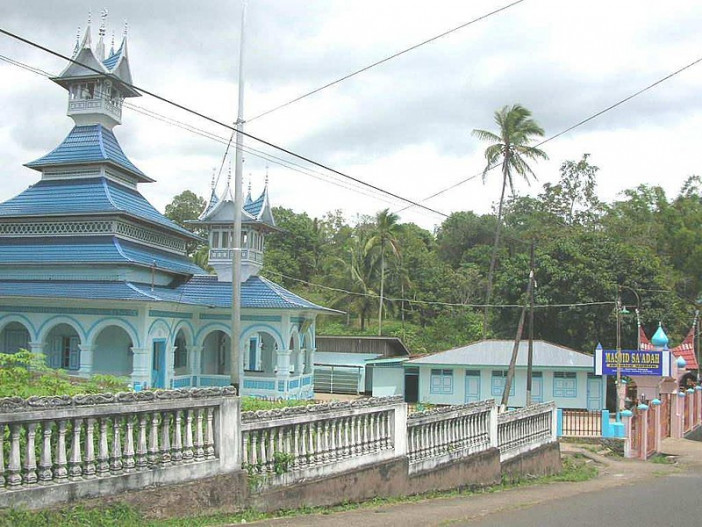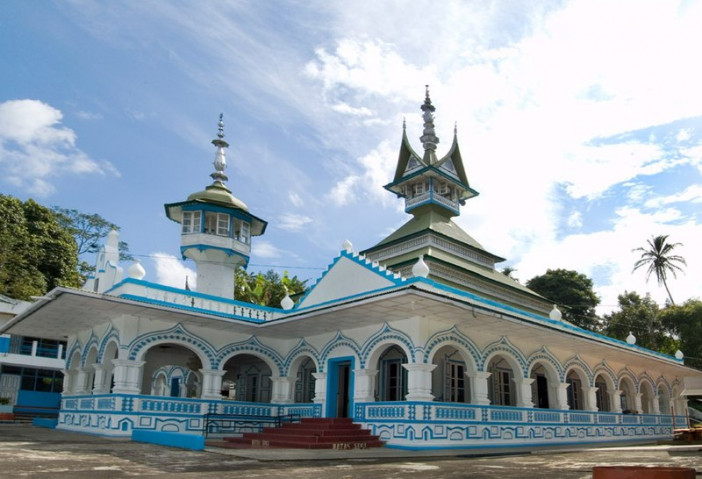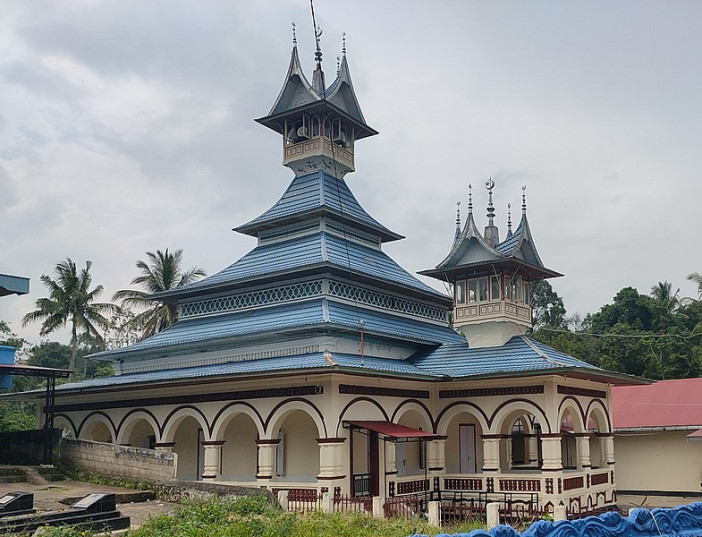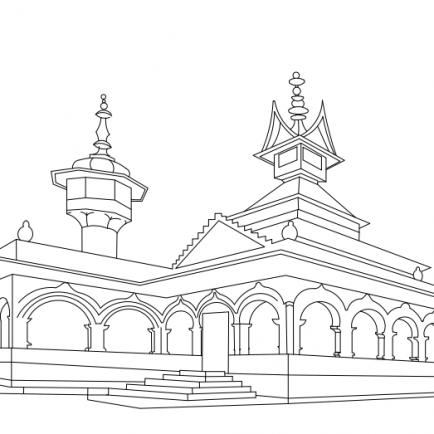Saada Mosque
History
This mosque was built around 1910 and began to be used in 1917. Before this mosque was built, a mosque had previously stood in the same place whose building was still made of wood . The name of this mosque, which in Arabic means happy, was given by a local cleric , namely H. Ramli Bakar. Initially, the construction of this mosque was donated by a local community leader, namely Ismail Datuk Paduko Intan and involved a Chinese from Padang as the architect .
Urban and Architectural
The main building of the mosque is a prayer hall with a square layout . The floor is still an ordinary cement floor , while the floor on the terrace or porch has been replaced with a white tiled floor. Inside the room, there are four main pillars to support the roof with supports that do not use iron , but only use bamboo . According to the local community, the four poles represent words in Minangkabau custom , namely the word slope, the word horizontal, the word climb, and the word descend
Like other typical Minangkabau mosque architecture , the roof of this mosque consists of several levels that are slightly concave, except that at the top roof level there is a square-shaped space crowned by four tapering roofs; the same room is also located on the roof of the façade . According to the local community, the five-tiered roof symbolized the five tribes at that time, namely Koto , Piliang , Bendang, Koto Anyiah, and Pitopang .
Overall the architecture of this mosque slightly resembles the architecture of the Rao Rao Mosque in Nagari Rao Rao , Tarab River . In a speech commemorating the 100th anniversary of the Rao Rao Mosque in 2008, Shodiq Pasadigoe , the Regent of Tanah Datar at that time stated that this mosque had indeed been asked to build similar to the Rao Rao Mosque.
Description
Saadah Mosque or As-Saadah Mosque is one of the oldest mosques in Indonesia which is located in Nagari Gurun , Sungai Tarab District , Tanah Datar District , West Sumatra . The mosque, which was put into use in 1917, was built in 1910 with an architecture that slightly resembled the Rao Rao Mosque in Nagari Rao Rao , Tarab River.
Currently, besides being used for Muslim worship activities , this mosque is also used as a means of religious education for the surrounding community. This mosque has been designated by the Indonesian Minister of Culture and Tourism as a cultural heritage object along with several other old mosques in West Sumatra, such as the Bingkudu Mosque in Canduang Koto Laweh , the Rao Rao Mosque, and the Raya Ganting Mosque in Padang
References
https://id.wikipedia.org/wiki/Masjid_Saadah
https://padang.tribunnews.com/2019/05/13/masjid-as-saadah-berusia-ratusan-tahun-di-tanah-datar-ornamen-kolonial-islam-china-dan-minang
Details
Location
Nagari Gurun , Sungai Tarab District , Tanah Datar District , West Sumatra
Worshippers
500
Owners
Indonesian Mosque Council
Architect Name
Year of Build
1910
Area
800
Drawings
Map
History
This mosque was built around 1910 and began to be used in 1917. Before this mosque was built, a mosque had previously stood in the same place whose building was still made of wood . The name of this mosque, which in Arabic means happy, was given by a local cleric , namely H. Ramli Bakar. Initially, the construction of this mosque was donated by a local community leader, namely Ismail Datuk Paduko Intan and involved a Chinese from Padang as the architect .
Urban and Architectural
The main building of the mosque is a prayer hall with a square layout . The floor is still an ordinary cement floor , while the floor on the terrace or porch has been replaced with a white tiled floor. Inside the room, there are four main pillars to support the roof with supports that do not use iron , but only use bamboo . According to the local community, the four poles represent words in Minangkabau custom , namely the word slope, the word horizontal, the word climb, and the word descend
Like other typical Minangkabau mosque architecture , the roof of this mosque consists of several levels that are slightly concave, except that at the top roof level there is a square-shaped space crowned by four tapering roofs; the same room is also located on the roof of the façade . According to the local community, the five-tiered roof symbolized the five tribes at that time, namely Koto , Piliang , Bendang, Koto Anyiah, and Pitopang .
Overall the architecture of this mosque slightly resembles the architecture of the Rao Rao Mosque in Nagari Rao Rao , Tarab River . In a speech commemorating the 100th anniversary of the Rao Rao Mosque in 2008, Shodiq Pasadigoe , the Regent of Tanah Datar at that time stated that this mosque had indeed been asked to build similar to the Rao Rao Mosque.
Description
Saadah Mosque or As-Saadah Mosque is one of the oldest mosques in Indonesia which is located in Nagari Gurun , Sungai Tarab District , Tanah Datar District , West Sumatra . The mosque, which was put into use in 1917, was built in 1910 with an architecture that slightly resembled the Rao Rao Mosque in Nagari Rao Rao , Tarab River.
Currently, besides being used for Muslim worship activities , this mosque is also used as a means of religious education for the surrounding community. This mosque has been designated by the Indonesian Minister of Culture and Tourism as a cultural heritage object along with several other old mosques in West Sumatra, such as the Bingkudu Mosque in Canduang Koto Laweh , the Rao Rao Mosque, and the Raya Ganting Mosque in Padang








